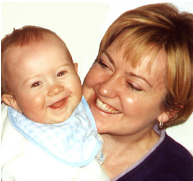Closely Spaced ChildrenBurton White
As for the advantages of having siblings, I can think of none if the spacing is narrow (less than two and one-half or three years). There is little question in my mind that the difficulties associated with having closely spaced children under age three constitutes the single most pressing concern for families of young children. Among the hundreds of questions that have been addressed to me since the publication of The First Three Years of Life, the most common concerns this particular situation. As I've said (in that book and this one), there really is no way to eliminate the difficulties associated with the situation. All you can hope to do is keep the problems within reasonable limits. Recently in my talks to groups on this subject I have used the following kind of story to express just how difficult it is for a two-year-old when a younger brother or sister arrives in the home. He's in the same situation a woman would be in if her husband one day announced to her, "Honey,. I've got wonderful news for you. Next week I'm planning to bring home someone else to live with us. It'll be a woman; she'll be a bit younger than you, perhaps a little bit more attractive. In any event, she'll seem that way because I plan to spend more time with her than with you; nevertheless, we're all going to continue to be a very happy family. You'll get used to her presence and I very much want you not only to love her but to show how much you love her." Most women would find this eventuality intolerable, so how on earth can we expect a two-year- old, whose whole life revolves around the home and the people who care for him, to be able to adjust to such a change? The only toddler who wouldn't be extremely jealous and unhappy about the presence of a nine-or ten-month-old sibling would be one who had very little to lose; and the only kind of two-year-old with very little to lose would be one who had not formed a basic attachment to his own mother. In a sense, then, the resentment of a two-year-old toward a younger sibling is reasonably good proof that that older child has formed normal, beneficial ties to his mother. It's very important for parents to recognize that two closely spaced young siblings are living in a chronically difficult state. You shouldn't just hope that the troubles will automatically sort themselves out. They usually do not. A special effort is needed to help both children get through their first few years together. The problems do not often begin during pregnancy or even soon after the child is born. Normally, the older child will maintain his good temper until the new baby starts to crawl, at which point the infant not only needs more of the parents' attention, but is also probably getting into the older child's toys as well. The older child may try to hit the baby or otherwise hurt him. He may regress, that is, become more babyish himself: take to crawling if he is walking; go back to a pacifier or bottle; return to negativism and tantrums; return to wetting his pants if he is already toilet trained. Or he may show signs of being unhappy, appear sad, cling to his mother, burst into tears for no apparent reason. The number of different ways in which slightly older children reveal their jealousy in such situations is remarkably large... Hard as it is on parents, the fact is that when there are two very young children in the home, both need special attention, and the parents' job is therefore going to be at least twice as demanding as it was before. Let me once again repeat my caveat. There is simply no way of making this situation as easy to live with as dealing with a first child only or with widely spaced children. It is very important that both parents understand that fact. Excerpted from Chapter 6, Special Problems: "Coping With Sibling Rivalry" and "The Sibling Versus the Only Child" pp 152-156 of A PARENTS GUIDE TO THE FIRST THREE YEARS by Burton L. White Copyright 1980 Burton L. White. Published by Prentice-Hall, Inc. Englewood Cliffs, N.J. 07632. Dr. White's best known book. THE FIRST THREE YEARS OF LIFE. (referred to above), was first published by Prentice-Hall in 1975.Dr. White's latest book THE NEW FIRST THREE YEARS OF LIFE, ISBN 0-684-80419-0, was released in 1995 to very flattering reviews. "...If reading Spock, Leach or Brazelton is chatting with experts over coffee, reading White is like having a professional consultation." (Publishers Weekly)
|
Honey, I've got wonderful news for you...
...the difficulties associated with having closely spaced children under age three constitutes the single most pressing concern for families of young children. It's very important for parents to recognize that two closely spaced young siblings are living in a chronically difficult state.
The number of different ways in which slightly older children reveal their jealousy is remarkably large.
As for the advantages of having siblings, I can think of none if the spacing is narrow (less than two and one-half or three years).
There is simply no way of making this situation as easy to live with as dealing with a first child only or with widely spaced children. It is very important that both parents understand that fact.
The young child who must constantly compete with a close older or younger sibling (or both) is often handicapped in her development by the stress and sometimes even the danger of her situation.
|

Website of
The Canadian Society
for the
Prevention of Cruelty to Children
Empathic Parenting
LINKS
|
|
